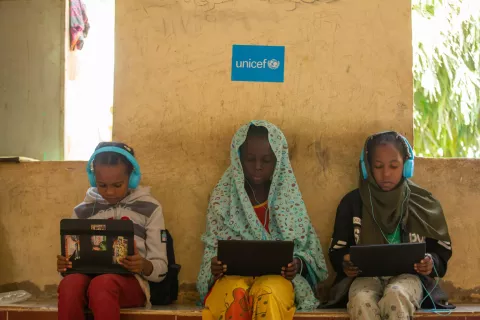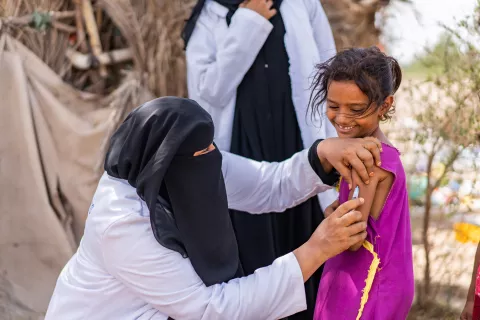One year on: A community in Darfur built from ashes
A temporary settlement transforms from squalid chaos to a hub of people leading their daily lives closer to normalcy

SORTONY, Sudan, 25 May 2017 – “The site at Sortony is a cramped shantytown in the making. UNICEF, as part of the first multi-agency humanitarian team to come to assess the situation, is navigating a maze of families, of children scraping for food, of donkeys, and, in the absence of any facilities, of open defecation fields. This valley is not prepared for an influx on this scale. It has no clinics, no schools, no areas for children to play in, no shelter, no prospects. All eyes are on us; the expectations to respond to the alarmingly intensifying humanitarian emergency are palpable.”
I wrote these words in February 2016. UNICEF and other humanitarian agencies had just reached this isolated site in North Darfur to assess the assistance needed by the thousands of people displaced by the Jebel Marra crisis.
More than 100,000 people were displaced in North Darfur alone. Over 90 per cent of them were women and children.
Sortony is one of the temporary settlements born out of the crisis, amassing 21,500 displaced people from dozens of small villages.
The site turned one year in February 2017. And it is worthy of celebration.

Women queuing at a UNICEF supported water point
Building a home
At face value, Sortony may not strike you as a haven of safety or plenty, but it is a major step up from what it was before. The squalid tent chaos has turned into a dynamic hub of people.
For the people fleeing the devastation, Sortony is a place of life. This may not be normality, but despite the odds, the people of Sortony have created a community. Street vendors, brick makers, a mosque, schools, clinics and water queues – where women meet each other for daily exchanges – all make up daily life.
The community opens its doors to strangers and children will take you by the hand to their favourite playing grounds. Watching the thousands of children run with unparalleled enthusiasm to schools at the crack of dawn is, quite possibly, one of the most life affirming sights you can come across.

Sortoni in February 2016 at the height of the emergency
Seizing opportunities
In the makeshift town of thatched huts and the labyrinth of passageways there are over 6,000 school-age children. In the congested class rooms, they hang on to every word the teachers say, attentive and eager to learn. After classes, the children sit on the grounds of the school yard under the blazing sun, unfazed and determined to cram as much knowledge as they can.
For the volunteer teacher Al Fadil, his role is to not only teach the children the curricula, but to pass on life skills. During the day, he teaches the children. At night, he holds a small class for the adults.
Displaced himself, he knows the challenges of adapting from a small village to a crowded town life. “Learning history enables children to become familiar with the past, to understand why events happened. It is important to encourage them, as they need confidence,” he says.
Against all odds, the children of Sortony grab every opportunity to build a future. Daranaim, 17, has begun learning at the Sortony girls’ school, which, along with the boys’ school, provides education to over 5,500 children. She is in grade 2 and many of her class mates are below 8 years old.
“In my home village, I would help my mother with the farm. Life was good before the conflict reached us. The villages were safe. I didn’t even realize I was missing out on schooling,” she says. “[In Sortony] I saw it was good to stay here when the schools were constructed. Education is important, even though I didn’t know this before. I could not even write my name – now I am learning. We need to educate our children. I want to be a teacher, to teach others how to read, to calculate, and to sing traditional songs in Fur to keep the language alive.”
The strength of a community
‘Shuweya shuweya‘ little by little, the displaced people of Sortony are creating pathways to normality and rebuilding their lives. Sometimes that’s as simple as a skipping rope or a game of football. They sing songs to keep their stories and collective memory alive. At nights, the hills are dotted with small fires for light, as families gather to recite verses, eat dinner and recount the day together.
Although UNICEF was one of the first agencies to respond to the calls for humanitarian assistance, the fiercest efforts were made by the people themselves: the mothers who looked after separated children found fleeing alone, the community leaders who volunteered to search for missing people and reunite families, the collective effort to establish structures within an emergency that had unravelled the social fabric.
Sortony might be a temporary settlement, but it stands as a compelling reminder of the endurance and strength of a community that is determined to build a better future for their children.



